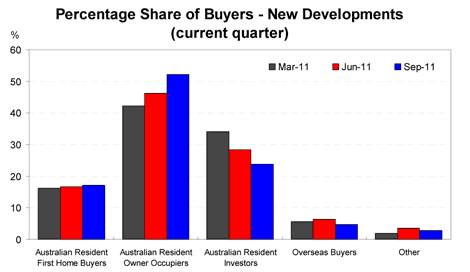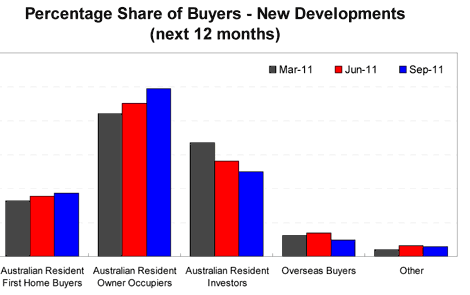Owner-occupier demand rises while house prices drop 2.4%: NAB
Owner-occupier demand for new housing is picking up while investor demand has shrunk, according to NAB’s September quarter survey of residential property.
The increased participation from owner-occupiers comes as house prices fell 2.4% over the quarter, while gross rents rose just 0.7%.
Demand from owner-occupiers increased by 6% over the September quarter to account for 52% of total demand while investor demand dropped to just 24%, after falling to 28% in the June quarter and 34% in March.

According to NAB, the drop in investor demand is consistent with “recent data showing a slowdown in housing lending for investment purposes”.
The drop in demand for new housing from investors is in line with declining expectations, with survey particpants (estate agents, owners, investors, etc) now expecting investors to account for about 25% of the market over the next 12 months, with owner-occupier demand expected to be up around the 50% mark.
The shares of first home buyers and overseas buyers in the market were broadly unchanged at 17% and 6% respectively over the September quarter is expected to remain broadly unchanged over the next 12 months.

Overall, the NAB Residential Property Index – a measure of house price and rental expectations - fell to 14 points in September following a five-point drop in June.
However, the index conceals considerable variation among the states, with conditions identified as being much weaker in Queensland, Victoria and SA/NT.
NSW and WA bucked the national trend and managed to produce small index gains.
Looking ahead, expectations have weakened relative to the last survey with the national index expected to be softer on the back of weaker house price expectations in Victoria and a more subdued outlook for rents in all states, bar NSW.
Survey respondents identified tight credit conditions as their most “significant” concern in the September quarter - a result that was consistent among all the states - but seen as being a “very significant” constraint in SA/NT and WA.
Housing affordability replaced rising interest rates as the next biggest constraint on new property developments in September, with these concerns also assessed as “significant” and slightly more so than in June.
Housing affordability concerns were most prevalent in Victoria, which is consistent with HIA data showing that Melbourne was the least affordable place in the country to purchase a home during the June quarter.